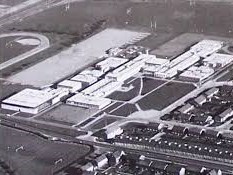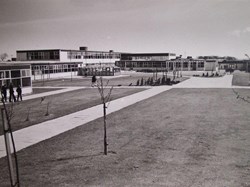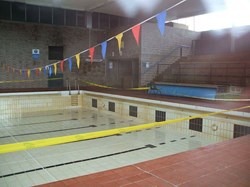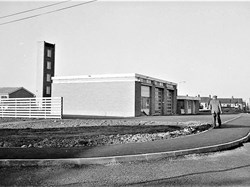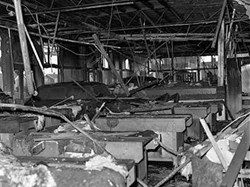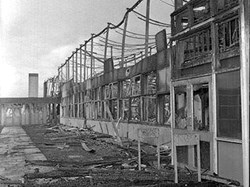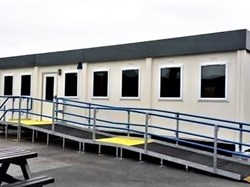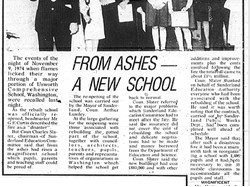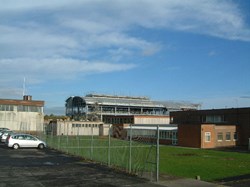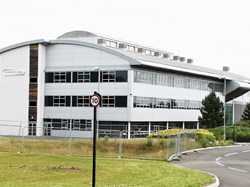Usworth School Fire 1974
This research is based on a presentation to Washington History Society members by Dave Walmsley at the WHS meeting on the 9th Nov 2019. Dave was a trainee Fire Officer at the time of the fire.
Usworth Comprehensive School
With the introduction of Comprehensive Education in the 1960s, Usworth School was built on green belt land on the northern edge of the town, catering for pupils living on the North side of Washington. The school opened in July 1969, and pupils and school staff from Washington Grammar School, and the two Usworth Secondary Modern Schools were transferred to the new building; a total of over 1500 pupils. Marshall Craig was the first Headmaster. The school was the only one in the area at that time to have its own swimming pool.
The Fire
The fire was first reported by a member of the public at around 9pm on Saturday 9th November 1974. A clock in the school’s Auckland House office was later found to have stopped at 9.15pm. Theories vary about the cause of the fire. There had been a spate of school fires, some deliberately started, in the area around that time, including one at Pelton Roseberry School just a few days earlier. Another possible cause was an electrical fault. The school switchboard in the office had been moved earlier in the week. However the true cause of the fire was never discovered.
A fire engine from Washington Fire Station was quickly despatched to the scene. Washington Fire Station was at that time located in Concord near the Stile Inn and Gardeners Club. It has since been demolished and a new station has been built on the Glover Industrial Estate. The fire pump was manned by Station Officer Fenwick, Driver Eric Thompson, and Fire Officers Tom Copeman and Billy Mc Camley, both of whom were equipped with breathing apparatus.
On arrival at the school the fire crew began tackling the blaze, which was centred in the area of the Headmaster’s Study. The fire appeared to be confined to a relatively small area, and it was initially thought that it could be brought under control by the Washington fire crew without outside assistance. Several fire engines from other Brigades, which were by then on their way to the fire, were informed by radio that they should turn around and return to their home stations.
Tom Copeman remembers that his crew had the initial blaze under control, and were in the process of “damping down” the fire when he noticed that windows were blowing out, and fires were appearing further along the block. What was not known at the time was that, due to the “CLASP” method of construction of the school, the fire had spread, unseen, along gaps between walls and ceilings.
The flawed CLASP- Consortium of Local Authorities Special Programme- system was devised in the 1950s to allow buildings to be built quickly and cheaply. It was adopted by a number of Local Authorities nationally, including Durham County Council. The system was selected for a number of school building projects and by the 1970s was in widespread use throughout the country and abroad. The dangers of using the CLASP system, which included the use of flammable materials and the lack of inbuilt fire-stopping measures, were later publicly exposed in a Panorama TV programme, in which Tyne & Wear’s Chief Fire Officer, Pat Watters, participated.
The fire quickly spread. Eventually around twenty fire engines arrived on the scene, but the delay caused by the initial decision to turn around fire appliances meant that the fire was out of control by the time additional help arrived. The situation was exacerbated by a high, gusting wind that helped spread the fire. Fire appliances were sent from Hebburn, Gateshead, Sunderland, and from a number of stations in Northumberland.
It was then discovered that there were problems with the water supply to hoses, due to low mains pressure in the area. Water had to be pumped from other sources. Initially water was taken from the school swimming pool, and, when that was drained, hoses were linked to the nearest high pressure mains supply at the Stephenson industrial estate near to Usworth Hall several hundred yards away.
Despite valiant efforts by the Fire Service, the main body of the school was destroyed. The fire was not fully extinguished until the afternoon of the next day. Classrooms, offices laboratories, libraries, toilets etc. were burnt out. The only surviving parts of the school were the outlying buildings-the separate House blocks, the PE area and the swimming pool.
Although the damage was extensive, at least there were no fatalities, although deaths had occured in some “Clasp-built” buildings abroad. The use of flammable building materials and dangerous building methods are issues which are still being debated today, especially after the 2017 Grenfell Tower fire in London.
A New School Arises from the Ashes.
The main priority after the fire was to get pupils back to school as soon as possible. Large areas of the school had been destroyed and new premises had to be urgently found to accommodate pupils. New school supplies also needed to be ordered. Eventually arrangements were made to hold classes in locations throughout the Washington area, including:-
The top floor of Donwell Primary School
Sulgrave Village Hall
Usworth Scout Hut
Columbia Scout Hut
Glebe Welfare Hall
Usworth Miners Hall
The Oval Community Centre
High Usworth Church Hall
St Robert’s School
Washington School
Buses were hired to transport pupils to the various locations. Later, prefabricated buildings were erected so that all pupils could be located on the one site again. New school buildings were eventually erected using more traditional methods and materials, and in January 1978, four years after the fire, the new school was formally reopened.
Closure and Demolition
In December 2003 it was announced that, due reorganisation of post 16 education in the City of Sunderland, Usworth comprehensive school was to close, and in 2006 it finally closed it’s doors. It had however been decided that a new Sixth Form College should be built on the site, and construction began even before the existing school was demolished.
This new College opened its doors in September 2006. However now it is part of Sunderland College, the site of its higher education provision for up 850 students.
